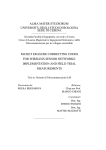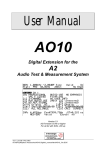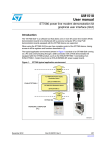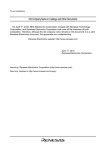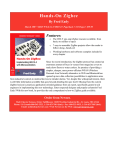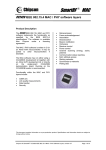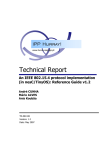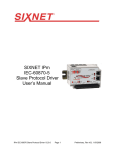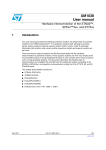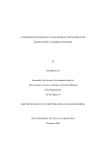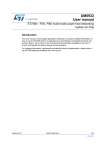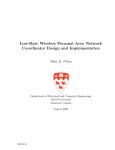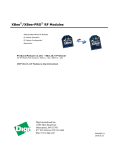Download ST7580 802.15.4-like MAC layer
Transcript
AN4411
Application note
ST7580 802.15.4-like MAC layer
By Nunzio Dipaola
Introduction
The new smart-grid systems and the emerging “Internet of things” concept require
advanced web services based on the TCP/IPv6 communication protocol. The TCP/IPv6
stack has been adapted to narrow band communication systems thanks to the work of the
6LowPAN working group of the IETF for narrow band wireless PANs, based on the IEEE802.15.4 compliant MAC layer.
The same concept can extended to narrow band wired power line communication networks
by implementing an 802.15.4-like MAC layer on a 32-bit microcontroller of the STM32
family, on top of the ST7580 multi mode power line networking SoC. The ST7580 device
inside the STarGRID family offers sufficient flexibility to support such protocol and even the
STM32F103 MCU has been used for the first firmware release; it can be ported to other
devices in the STM32 family.
This document describes the communication protocol and the services provided to the
upper layers of the protocol stack.
June 2014
DocID025597 Rev 1
1/29
www.st.com
Contents
AN4411
Contents
1
Overview . . . . . . . . . . . . . . . . . . . . . . . . . . . . . . . . . . . . . . . . . . . . . . . . . . 5
2
Firmware architecture . . . . . . . . . . . . . . . . . . . . . . . . . . . . . . . . . . . . . . . . 6
3
Framing . . . . . . . . . . . . . . . . . . . . . . . . . . . . . . . . . . . . . . . . . . . . . . . . . . . 8
4
Service description . . . . . . . . . . . . . . . . . . . . . . . . . . . . . . . . . . . . . . . . . 11
4.1
Address structure . . . . . . . . . . . . . . . . . . . . . . . . . . . . . . . . . . . . . . . . . . . .11
4.2
Data services . . . . . . . . . . . . . . . . . . . . . . . . . . . . . . . . . . . . . . . . . . . . . . 12
4.3
5
4.2.1
MCPS-DATA.request . . . . . . . . . . . . . . . . . . . . . . . . . . . . . . . . . . . . . . . 12
4.2.2
MCPS-DATA.confirm . . . . . . . . . . . . . . . . . . . . . . . . . . . . . . . . . . . . . . . 13
4.2.3
MCPS-DATA.indication . . . . . . . . . . . . . . . . . . . . . . . . . . . . . . . . . . . . . 13
Management services . . . . . . . . . . . . . . . . . . . . . . . . . . . . . . . . . . . . . . . 14
4.3.1
MLME-BEACON-NOTIFY.indication . . . . . . . . . . . . . . . . . . . . . . . . . . . 14
4.3.2
MLME-GET.request . . . . . . . . . . . . . . . . . . . . . . . . . . . . . . . . . . . . . . . . 15
4.3.3
MLME-GET.confirm . . . . . . . . . . . . . . . . . . . . . . . . . . . . . . . . . . . . . . . . 15
4.3.4
MLME-SET.request . . . . . . . . . . . . . . . . . . . . . . . . . . . . . . . . . . . . . . . . 16
4.3.5
MLME-SET.confirm . . . . . . . . . . . . . . . . . . . . . . . . . . . . . . . . . . . . . . . . 17
4.3.6
MLME-RESET.request . . . . . . . . . . . . . . . . . . . . . . . . . . . . . . . . . . . . . . 17
4.3.7
MLME-RESET.confirm . . . . . . . . . . . . . . . . . . . . . . . . . . . . . . . . . . . . . . 18
4.3.8
MLME-SCAN.request . . . . . . . . . . . . . . . . . . . . . . . . . . . . . . . . . . . . . . 18
4.3.9
MLME-SCAN.confirm . . . . . . . . . . . . . . . . . . . . . . . . . . . . . . . . . . . . . . 18
4.3.10
MLME-START.request . . . . . . . . . . . . . . . . . . . . . . . . . . . . . . . . . . . . . . 19
4.3.11
MLME-START.confirm . . . . . . . . . . . . . . . . . . . . . . . . . . . . . . . . . . . . . . 19
4.3.12
MLME-COMM-STATUS.indication . . . . . . . . . . . . . . . . . . . . . . . . . . . . . 20
4.3.13
MLME-SYNC-LOSS.indication . . . . . . . . . . . . . . . . . . . . . . . . . . . . . . . 20
Application example . . . . . . . . . . . . . . . . . . . . . . . . . . . . . . . . . . . . . . . . 22
Appendix A Boot and join sequence . . . . . . . . . . . . . . . . . . . . . . . . . . . . . . . . . . 23
Appendix B Modem setup . . . . . . . . . . . . . . . . . . . . . . . . . . . . . . . . . . . . . . . . . . . 24
Appendix C PIB attributes . . . . . . . . . . . . . . . . . . . . . . . . . . . . . . . . . . . . . . . . . . . 25
2/29
DocID025597 Rev 1
AN4411
Contents
6
References . . . . . . . . . . . . . . . . . . . . . . . . . . . . . . . . . . . . . . . . . . . . . . . . 27
7
Revision history . . . . . . . . . . . . . . . . . . . . . . . . . . . . . . . . . . . . . . . . . . . 28
DocID025597 Rev 1
3/29
29
List of figures
AN4411
List of figures
Figure 1.
Figure 2.
Figure 3.
Figure 4.
Figure 5.
4/29
Firmware architecture . . . . . . . . . . . . . . . . . . . . . . . . . . . . . . . . . . . . . . . . . . . . . . . . . . . . . . 6
PSK frame . . . . . . . . . . . . . . . . . . . . . . . . . . . . . . . . . . . . . . . . . . . . . . . . . . . . . . . . . . . . . . 8
Fields of the MAC frame . . . . . . . . . . . . . . . . . . . . . . . . . . . . . . . . . . . . . . . . . . . . . . . . . . . . 8
EVALKITST7580-1 . . . . . . . . . . . . . . . . . . . . . . . . . . . . . . . . . . . . . . . . . . . . . . . . . . . . . . . 22
Boot and association of a new node. . . . . . . . . . . . . . . . . . . . . . . . . . . . . . . . . . . . . . . . . . 23
DocID025597 Rev 1
AN4411
1
Overview
Overview
The 802.15.4-like communication MAC layer provides services able to build and manage a
power line network with a master node referred to as “network coordinator” and several peer
nodes called “coordinators”.
Any type of power line network may be created.
In order to start transmissions, a coordinator node needs to join the network; it performs an
association procedure called “active scan”.
The protocol has been created for the STM32 family microcontrollers. It assumes a serial
communication line (UART) is used to communicate and exchange data with the ST7580
power line modem device.
DocID025597 Rev 1
5/29
29
Firmware architecture
2
AN4411
Firmware architecture
Figure 1 shows the firmware architecture:
Figure 1. Firmware architecture
The ST7580 power line modem provides physical layer services together with some basic
data link layer services. The role of each block is as follows:
•
st7580_wrapper: this module works as a wrapper for any access to the modem. When
transmitting, this module sends frames to the modem and manages the local port
acknowledgments (UART communication). When receiving, this module analyzes the
packet and sends the related event to the right FSM among the MAC machines. The
outgoing packets are evaluated by the CSMA/CA JAS anti-collision module in order to
obey the medium access protocol rules; the only exceptions are ACK packets and all
the segments of a series, excluding the first.
•
MAC: this is a set of modules which provides all the functionality of the data link layer.
Here, several FSMs work together to execute requests issued from the higher layer
and manage the data gathered by the modem from the power line (such as other nodes
in the network in a neighbor table, the quality level of the medium and internal data
structures).
•
MacSapInterface: this module provides a unique, clean interface to the whole set of
MAC services including request, confirmation and indication primitives. This modules is
the interface for the application layer which is built upon the power line network device.
Table 1 shows the source files involved in any block.
Table 1. Module details
6/29
Block
Modules
Notes
st7580_wrapper
ST7580_Layer\st7580_wrapper (c/h)
ST7580_Layer\st7580_serial20 (c/h)
BSP\STM32_EVAL\st7580_stm32_bsp (c/h)
Very low-level modules.
DocID025597 Rev 1
AN4411
Firmware architecture
Table 1. Module details
MAC
MAC\MacConstants.h
MAC\MacEnumeration.h
MAC\MacFrameCreation/Handling (c/h)
MAC\MacFSM* (c/h)
MAC\MacMessageCatalog.h
MAC\MacNeighbourTable (c/h)
MAC\MacPanDescriptorMng (c/h)
MAC\MacPibAttributes (c/h)
MAC\MacPIBTypes.h
MAC\MacSapQueue (c/h)
DataLinkLayer\channel_access (c/h)
DataLinkLayer\csmaca (c/h)
DataLinkLayer\timers (c/h)
The source files in
DataLinkLayer\subfolder are
dedicated to the CSMA/CA
JAS access protocol; this can
be enabled at build time by
declaring a special macro
ENABLE_CSMA_CA
(default). If this macro is not
declared, no access protocol
is used.
MacSapInterface
MAC\MacSapInterface (c/h)
Applications may be built
using the API these modules
provide.
DocID025597 Rev 1
7/29
29
Framing
3
AN4411
Framing
The adopted modulation is an X-PSK and the physical frame is the typical PSK frame,
shown in Figure 2.
Figure 2. PSK frame
Where:
•
Preamble: 32 bit (this field is detected as start-of-frame signal by the receiver)
•
Unique word: 32 bit (fixed content - the receiver evaluates SNR of the medium
depending on the perceived quality of this field)
•
Mode: 8 bit (this field specifies the modulation scheme for the incoming payload – in
this protocol version, it is always set to B-PSK)
•
P_SDU Length: 8 bit (length of the P_SDU field in bytes)
•
P_SDU: variable field, from 0 up to 248 bytes (this is the actual frame payload)
The P_SDU field contains the MAC PDU with the structure shown in figure 3.
Figure 3. Fields of the MAC frame
The content of each field is detailed below.
Segment control header
This field stores useful data for segmentation and reassembly routines (Table 2).
Table 2. Fields of the segment control header
8/29
Field
Byte
Used bits
Bit length
Details
RES
0
7-2
6
Reserved
CAP
0
1
1
Channel Access Priority
(1: high, 0: normal)
LSF
0
0
1
Last Segment Flag (1: yes, 0: no)
SC
1
7-2
6
Segment Count
SL[9-8]
1
1-0
2
Segment Length
SL[7-0]
2
7-0
8
Segment Length
DocID025597 Rev 1
AN4411
Framing
Note that the SL field stores the length of a generic segment in a series, not the actual
segment. Therefore, when sending a 140 byte packet, while the actual segment size is 60
bytes, this field is set to 60 in segment #1, then 60 in segment #2 and 60 again in segment
#3, even if this last segment only holds the last 20 bytes.
Frame control header
This field is used for specifying the frame type and the addressing modes (table 5).
.
Table 3. Frame control header
Field
Byte
Used bits
Bit length
Details
Frame type
0
0-2
3
Frame type (see notes)
Security enabled
0
3
1
Always zero
Frame pending
0
4
1
Always zero
Ack request
0
5
1
Acknowledgment requested
PAN ID compression
0
6
1
Enabled/disabled (see notes)
Reserved
0, 1
7, 0-1
3
Dest. addr. mode
1
2-3
2
Addressing mode (see notes)
Frame version
1
4-5
2
Always zero
Source addr. mode
1
6-7
2
Addressing mode (see notes)
The “frame type” field is set to one of the allowed values:
•
000 = Beacon
•
001 = Data frame
•
010 = Acknowledgment
•
011 = MAC Command frame
•
100-111 are reserved
The “PAN ID compression” field saves (in some cases) two bytes: when both the source
address and the destination address are present and the source PAN ID is identical to the
destination PAN ID, then this field may be set to one (enabled) and only the destination PAN
ID is copied into the frame (source address doesn’t have an explicit PAN ID). In any other
case, this field is set to zero.
The “addressing mode” fields may be set to one of the allowed values:
•
00 = address field is not present (that is, no address)
•
01 is reserved
•
10 = address field contains PAN ID and a 16 bit short address
•
11 = address field contains PAN ID and a 64 bit extended address
Sequence number
This field is under the MAC control. It specifies the sequence number of the frame, which is
useful for matching acknowledgments and distinguishing between subsequent
retransmissions. A BSN (beacon sequence number) is used for beacon frames and a DSN
(data sequence number) is used for data frames.
DocID025597 Rev 1
9/29
29
Framing
AN4411
Frame payload
This field is used for the MAC payload. Different frames are associated with different cases:
•
•
Beacon frame: the payload is 16-bits long and can be set to one of the following two
values:
–
MAC_BEACON_SUPERFRAME_PANCOORD (the sender node is a network
coordinator and association is allowed);
–
MAC_BEACON_SUPERFRAME_COORD (the sender node is a coordinator and
association is allowed);
MAC Command frame: the command itself is 8 bits long and the payload may vary.
Two different command frames are available:
–
MAC_BEACON_REQ_ID (Beacon Request Command Frame – only the
command code is specified, no payload);
–
MAC_IDENTITY_ANNOUNCEMENT (Identity Announcement Command Frame –
the command code is followed by the 16-bit short address and then by the 64-bit
extended address of the node);
•
Acknowledgment: no payload;
•
Data frame: any payload.
Frame check sequence
Not used. The physical layer of the ST7580 provides hardware error detection, so this field
is not filled with any data.
10/29
DocID025597 Rev 1
AN4411
4
Service description
Service description
The firmware offers a complete set of service primitives, as listed in Table 4.
Table 4. List of service primitives
MCPS-DATA
request
confirm
indication
yes
yes
yes
MLME-BEACON-NOTIFY
4.1
yes
MLME-GET
yes
yes
MLME-SET
yes
yes
MLME-RESET
yes
yes
MLME-SCAN
yes
yes
MLME-START
yes
yes
MLME-COMM-STATUS
yes
MLME-SYNC-LOSS
yes
Address structure
The address of a node is a commonly used data structure, so it is useful to acquire it
beforehand.
typedef struct {
uint8_t
Mode;
uint16_t PanID;
union {
uint16_t Short;
uint8_t
Extended[MAC_ADDR64_SIZE];
};
} MAC_DeviceAddress_t;
DocID025597 Rev 1
11/29
29
Service description
AN4411
where:
4.2
•
uint8_t Mode
is the address mode (see notes below table 5)
•
uint16_t PanID
is the 16-bit PAN Identifier
•
uint16_t Short
is the 16-bit short address
•
uint8_t Extended
is the 64-bit extended address (the macro MAC_ADDR64_SIZE has value 8)
Data services
The data services include all the primitives related to data transmission, that is, to MCPSDATA functions such as “request”, “confirm” and “indication”.
4.2.1
MCPS-DATA.request
uint8_t MAC_McpsDataReq(MAC_McpsDataReq_t *McpsDataReq);
This function is called when a data transmission is requested. Input data is a reference to a
MAC_McpsDataReq_t data structure with the following fields:
•
uint8_t SrcAddrMode
The source address mode, as listed in the notes below table 5.
•
MAC_DeviceAddress_t DstAddr
The destination address.
•
uint16_t MsduLength
The length in bytes of the MSDU. The firmware can handle messages up to
NEXT_HIGHER_LAYER_MAX_PDU_LENGTH bytes in length through segmentation. The
default value for NEXT_HIGHER_LAYER_MAX_PDU_LENGTH is 1280.
12/29
•
uint8_t *Msdu
Pointer to the MSDU.
•
uint8_t MsduHandle
The handle associated with the data to transmit.
•
uint8_t TxOptions
Special transmission options:
–
b0: 0 tx without ACK, 1 tx with ACK
–
b1: 0 CAP transmission (fixed)
–
b2: 0 direct transmission (fixed)
•
uint8_t SecurityLevel
Always zero.
•
uint8_t QoS
Requested Quality of Service: 1 high, 0 normal
DocID025597 Rev 1
AN4411
Service description
Return values:
4.2.2
•
MAC_SAP_ERR_NO_ERROR – operation completed successfully;
•
MAC_SAP_ERR_IMPLEMENTATION – no spare room in the event queue; other
operations are already being performed;
•
MAC_SAP_ERR_INVALID_ADDR_MODE – invalid source address mode or
destination address mode.
MCPS-DATA.confirm
uint8_t MAC_McpsDataConfirm(MAC_McpsDataConfirm_t *McpsDataConfirm);
This “confirm” function checks for the result of the last data transmission request. The input
object is a pointer to a MAC_Mcps_DataConfirm_t data structure consisting of the following
fields:
•
uint8_t ErrorCode
Error code of the MCPS-DATA.confirm operation – this field is never used in the current
firmware version.
•
uint8_t MsduHandle
The handle specified in the MCPS-DATA.request.
•
uint8_t Status
Status of the data transfer operation.
•
uint32_t Timestamp
Time at which the data transfer has been completed. Note: this is the device internal
time which counts the time in milliseconds following power-on.
Return values:
•
MAC_SAP_ERR_NO_ERROR – confirm event retrieved successfully;
•
MAC_SAP_ERR_PREVIOUS_REQUEST – no confirm event retrieved yet.
The “status” field may be set to one of the following:
4.2.3
•
MAC_SUCCESS – operation completed successfully;
•
MAC_INVALID_ADDRESS – both destination and source addresses are missing;
•
MAC_INVALID_QOS – a wrong value for QoS is requested (only 0/1 are valid);
•
MAC_ADD_EVENT_ERROR – unable to transmit the packet because the transmitting
machine is busy;
•
MAC_CHANNEL_ACCESS_FAILURE – unable to transmit because the channel is
busy;
•
MAC_NO_ACK – Ack (when requested) is not received.
MCPS-DATA.indication
uint8_t MAC_McpsDataIndication(MAC_McpsDataIndication_t
*McpsDataIndication);
This primitive is issued in case of data reception.
Ack packets (when requested) are handled internally by the MAC routines. The application
level receives confirmation of proper handling when an “indication” is signaled.
The “indication” signaling is also associated with a positive result from any frame corruption
(reserved fields/wrong values) check.
DocID025597 Rev 1
13/29
29
Service description
AN4411
Explanation of MAC_McpsDataIndication_t data structure:
•
uint8_t ErrorCode
The error code related to the reception event. Always set to the value
MAC_SAP_ERR_NO_ERROR.
•
MAC_DeviceAddress_t SrcAddr
The source address.
•
MAC_DeviceAddress_t DstAddr
The destination address. Note that this address has already been checked, so this
“indication” signal means the packet is in the correct desired destination node.
•
uint16_t MSDULen
Length in bytes of the packet.
•
uint8_t MSDU[NEXT_HIGHER_LAYER_MAX_PDU_LENGTH]
The actual MSDU.
uint8_t msduLinkQuality
SNR value detected during reception of this packet. In case of segmented reception, this
value derives from the latest received segment.
•
uint8_t DSN
Data Sequence Number. The sequence number identification of a single transmission.
•
uint32_t TimeStamp
Time of completion of the reception operation.
•
uint8_t SecurityLevel
Information about security setting (cryptography) of the frame. Not used in the current
version of the firmware.
•
uint8_t QoS
Requested quality of service set by the sender (0: normal quality, 1: high quality).
Return values:
4.3
•
MAC_SAP_ERR_NO_ERROR – the function returned a valid “indication” event;
•
MAC_SAP_ERR_NOINDICATION_PRESENT – no “indication” present, that is, no
packet received at the moment.
Management services
The following services involve the MLME (MAC subLayer Management Entity) and all the
internal MAC management.
4.3.1
MLME-BEACON-NOTIFY.indication
uint8_t MAC_MlmeBeaconNotify(MAC_MlmeBeaconNotify_t *MlmeBeaconNotify);
This primitive is issued when a node receives a beacon. The fields of the
MAC_MlmeBeaconNotify_t data structure are set as follows:
14/29
•
uint8_t ErrorCode
The error code returned by the reception operation.
•
MAC_PanDescriptor_t PanDescriptor
The data structure filled with data from the sender coordinator node.
DocID025597 Rev 1
AN4411
Service description
The return values:
•
MAC_SAP_ERR_NO_ERROR – a valid “indication” was retrieved;
•
MAC_SAP_ERR_NOINDICATION_PRESENT – no “indication” event is present.
The ErrorCode field is always set with value MAC_SAP_ERR_NO_ERROR.
The MAC_PanDescriptor_t structure has the following fields:
4.3.2
•
MAC_DeviceAddress_t CoordAddress
Address of the sender coordinator.
•
uint16_t SuperFrameSpec
The two-byte SuperFrameSpecification received as payload of the beacon.
•
uint8_t GTSPermit
Permission for GTS (guaranteed time slot). Not used in this protocol version; it is
always zero.
•
uint8_t LinkQuality
Signal quality at reception of the beacon, that is, the SNR detected during decoding.
•
uint32_t Timestamp
Arrival time of the beacon.
•
uint8_t SecurityFailure
This field signals problems during decryption of the frame. Not used in this protocol
version, always set to MAC_SUCCESS.
•
uint8_t SecurityLevel
Cryptographic protection level of the Beacon frame. Not used in this protocol version.
MLME-GET.request
uint8_t MAC_MlmeGetReq(MAC_MlmeGetReq_t *MlmeGetReq);
This primitive requests a “get” (read) operation on the MAC internal database, PIB (PAN
Information Base), providing the object that the function must read.
Fields of the MAC_MlmeGetReq structure:
•
uint32_t PIBAttribute
Integer ID of the attribute to read. See Appendix 3 for Attribute list.
•
uint8_t PIBAttributeIndex
Index used in case of list-attribute.
Return values:
•
MAC_SAP_ERR_NO_ERROR – the primitive was issued with no errors;
•
MAC_SAP_QUEUE_ERRFULL – unable to issue the event to the FSM.
The only list attribute managed by the MAC is the neighbor table, which contains information
about any known node of the network. Its ID is MAC_NEIGHBORTABLE_ID.
4.3.3
MLME-GET.confirm
uint8_t MAC_MlmeGetConfirm(MAC_MlmeGetConfirm_t *MlmeGetConfirm);
This function checks whether a “confirm” event has been issued following a previous
GET.request and returns the attribute value.
DocID025597 Rev 1
15/29
29
Service description
AN4411
Explanation of the MAC_MlmeGetConfirm data structure:
•
uint8_t ErrorCode
Result of the operation, always MAC_SAP_ERR_NO_ERROR.
•
uint8_t State
State flag of the GET operation; it may have one of the following values:
MAC_SUCCESS for a successful read, MAC_UNSUPPORTED_ATTRIBUTE when the
requested attribute is not found or MAC_INVALID_INDEX when a list attribute is
specified but the wrong index is provided.
•
uint32_t PIBAttribute
ID of the attribute
•
uint8_t PIBAttributeIndex
Attribute index for a GET operation on a list attribute.
•
uint8_t PIBAttributeValue[SAP_MAX_ATTRIBUTEVALUEGET_LEN]
The value retrieved by the GET operation. The buffer is
SAP_MAX_ATTRIBUTEVALUEGET_LEN bytes long (default 20), although 13 are
used at most.
•
uint8_t PIBAttributeValueLen
Length in bytes of the attribute.
Return values:
Note:
•
MAC_SAP_ERR_NO_ERROR – a valid “confirm” event was copied into the
MAC_MlmeGetConfirm data structure;
•
MAC_SAP_ERR_PREVIOUS_REQUEST – no “confirm” event was found.
The PIBAttributeValue buffer has different contents depending on the actual attribute. For a
read from the Neighbor Table, it is structured as a small set of integer values related to a
specified node, in the following sequence:
•
2 bytes for the actual PAN ID;
•
2 bytes for the actual short address (optional);
•
8 bytes for the extended address (optional);
•
1 byte for the age of the entry (in minutes).
This structure is therefore 5 bytes long (when only the short address is present) or 11 bytes
long (when only the extended address is present) or 13 bytes long (when both short and
extended address are present). In order to distinguish between these cases, refer to the
PIBAttributeValueLen value beforehand.
For integer values, the structure is simpler (1, 2, 4 bytes).
When reading the extended address of the current node, the PIBAttributeValue is set with a
pointer (32-bit value) to an 8-byte buffer with the long address.
4.3.4
MLME-SET.request
uint8_t MAC_MlmeSetReq(MAC_MlmeSetReq_t *MlmeSetReq);
16/29
DocID025597 Rev 1
AN4411
Service description
This function is called when a SET.request must be issued. The parameter contains the
attribute identifier and its new value. The MAC_MlmeSetReq_t data structure fields are:
•
uint32_t PIBAttribute
The integer identifier of the attribute to be set. See Appendix 3 for Attribute list.
•
uint8_t PIBAttributeIndex
The index for a list attribute.
•
union PIBAttributeValue
This field has one of the following values: value8 (unsigned 8-bit value), value16
(unsigned 16-bit value), value32 (unsigned 32-bit value), buffer (a generic buffer – its
length is SAP_MAX_ATTRIBUTEVALUESET_LEN bytes, defaulted to 4).
•
uint8_t PIBAttributeValueLen
Length in bytes of the value stored in the PIBAttributeValue field.
Return values:
4.3.5
•
MAC_SAP_ERR_NO_ERROR – the “request” primitive has been successfully issued
to the MAC;
•
MAC_SAP_QUEUE_ERRFULL – the FSM has no further room for a new SET.request
event.
MLME-SET.confirm
uint8_t MAC_MlmeSetConfirm(MAC_MlmeSetConfirm_t *MlmeSetConfirm);
This function checks for a SET confirm event. The MAC_MlmeSetConfirm_t data structure
has the following fields:
•
uint8_t ErrorCode
The error code returned from the “confirm” primitive; it is always
MAC_SAP_ERR_NO_ERROR.
•
uint8_t State
The state of the SET operation. It may have one of the following values:
MAC_SUCCESS (when there are no errors), MAC_UNSUPPORTED_ATTRIBUTE
(when the attribute is not found), MAC_READ_ONLY (the requested attribute is readonly).
•
uint32_t PIBAttribute
The 32 bit identifier of the specified attribute.
•
uint8_t PIBAttributeIndex
The index for a list attribute.
Return values:
4.3.6
•
MAC_SAP_ERR_NO_ERROR – the function call returns a valid “confirm” event;
•
MAC_SAP_ERR_PREVIOUS_REQUEST – no “confirm” event was found.
MLME-RESET.request
uint8_t MAC_MlmeResetReq(MAC_MlmeResetReq_t *MlmeResetReq);
This function requests a reset of the MAC layer. The MAC_MlmeResetReq_t data structure
has a single field:
•
uint8_t SetDefaultPIB
This flag tells the engine whether or not to reset the PIB during the software reset. Set
it to 1 to reset or 0 to leave it with latest values.
DocID025597 Rev 1
17/29
29
Service description
AN4411
The reset operation always involves a hardware reset of the ST7580 modem. The
PANDescriptorList and the neighbor table structures are also cleaned.
Return values:
4.3.7
•
MAC_SAP_ERR_NO_ERROR – the request was successfully issued;
•
MAC_SAP_ERR_IMPLEMENTATION – the Reset FSM was unable to accept a new
request.
MLME-RESET.confirm
uint8_t MAC_MlmeResetConfirm(MAC_MlmeResetConfirm_t *MlmeResetConfirm);
This function checks for a “confirm” for a previous RESET.request primitive. The
MAC_MlmeResetConfirm_t data structure has the following fields:
•
uint8_t ErrorCode
Result of the “confirm” event; it is always set to MAC_SAP_ERR_NO_ERROR.
•
uint8_t Status
Status of the reset operation; it always has the value MAC_SUCCESS.
Return values:
4.3.8
•
MAC_SAP_ERR_NO_ERROR – the “confirm” event was retrieved successfully;
•
MAC_SAP_ERR_PREVIOUS_REQUEST – no “confirm” event.
MLME-SCAN.request
uint8_t MAC_MlmeScanReq(MAC_MlmeScanReq_t *MlmeScanReq);
When a node starts up, the next layer above MAC calls the active scan procedure in order to
check the actual network status. This function issues the necessary primitive and other
nodes, if any, send their beacons. See Appendix A for the complete description of the join
procedure. The parameters in the MAC_MlmeScanReq_t are:
•
uint8_t ScanType
Select the scan type. Only Active Scan is allowed; set this to the value
MAC_ACTIVE_SCAN.
•
uint32_t ScanChannels
Used for selecting channels to check during the scan operation. Not used in this
protocol version.
•
uint8_t ScanDuration
Duration in seconds for the whole scan operation (max. is 60, a zero setting is not
allowed).
•
uint8_t ChannelPage
•
uint8_t SecurityLevel
These parameters are not used in this version of the software.
Return values:
4.3.9
•
MAC_SAP_ERR_NO_ERROR – the “request” event was successfully issued to the
Scan FSM;
•
MAC_SAP_ERR_IMPLEMENTATION – unable to send the request to the scan FSM.
MLME-SCAN.confirm
uint8_t MAC_MlmeScanConfirm(MAC_MlmeScanConfirm_t *MlmeScanConfirm);
18/29
DocID025597 Rev 1
AN4411
Service description
This function checks for a “confirm” event after a previous scan request. The
MAC_MlmeScanConfirm_t data structure has the following fields:
•
MAC_PanDescriptorList_t PanDescriptorList
This structure consists of an unsigned byte, PanDescriptorCount, which counts how
many Beacon frames have been received, and an array of MAC_PanDescriptor_t
PanDescriptor; these have the structure shown in Chapter 4.3.1.
•
uint8_t ErrorCode
Error code of the “confirm” event; it is always set to MAC_SAP_ERR_NO_ERROR.
•
uint8_t Status
Status of the Scan operation; it may have one of the following values: MAC_SUCCESS
(successfully completed), MAC_SCAN_IN_PROGRESS (another Scan sequence was
already pending), MAC_INVALID_PARAMETER (a wrong Scan value was specified for
the scan type and/or duration), MAC_ADD_EVENT_ERROR (unable to transmit the
Beacon Request Command frame), or any of the error codes returned by the
transmission FSM (listed in Chapter 4.2.2).
•
uint8_t ScanType
Always set to MAC_ACTIVE_SCAN.
Return values:
4.3.10
•
MAC_SAP_ERR_NO_ERROR – the “confirm” data was successfully retrieved;
•
MAC_SAP_ERR_PREVIOUS_REQUEST – no “confirm” event available.
MLME-START.request
uint8_t MAC_MlmeStartReq(MAC_MlmeStartReq_t *MlmeStartReq);
With this function, a node can set the PAN ID and its role in the network (coordinator/PAN
coordinator). The parameters are found in the MAC_MlmeStartReq_t structure:
•
uint8_t CoordRole
This flag controls whether the node is a PAN Coordinator (set this field to
DEVICE_TYPE_PAN_COORDINATOR) or a Coordinator (set this field to
DEVICE_TYPE_COORDINATOR)
•
uint16_t PanId
The 16 bit PAN identifier. Note that, although the application may choose this identifier
randomly, the protocol requires that it is logically and-ed with 0xFCFF.
Return value:
•
4.3.11
MAC_SAP_ERR_NO_ERROR – the request was issued to the MAC.
MLME-START.confirm
uint8_t MAC_MlmeStartConfirm(MAC_MlmeStartConfirm_t *MlmeStartConfirm);
When called, this function checks for a “confirm” event relative to a previous start request.
DocID025597 Rev 1
19/29
29
Service description
AN4411
The results are stored into the MAC_MlmeStartConfirm_t structure:
•
uint8_t ErrorCode
Error code from the “confirm” retrieval operation; it is always set to
MAC_SAP_ERR_NO_ERROR.
•
uint8_t Status
Status code of the Start operation; it may have the values
MAC_SAP_ERR_NO_ERROR (Start sequence completed successfully) or
MAC_INVALID_PARAMETER (the specified PAN ID is invalid).
Return values:
4.3.12
•
MAC_SAP_ERR_NO_ERROR – a valid “confirm” event is present;
•
MAC_SAP_ERR_PREVIOUS_REQUEST – no “request” was previously issued.
MLME-COMM-STATUS.indication
uint8_t MAC_MlmeCommStatusIndication(MAC_MlmeCommStatusIndication_t
*MlmeCommStatusIndication);
This function checks for a communication status “indication” event from the MAC, that is, a
detailed report about the last communication event. The
MAC_MlmeCommStatusIndication_t data structure has the following fields:
•
uint8_t ErrorCode
The error code of the “confirm” event check; it is always set to
MAC_SAP_ERR_NO_ERROR.
•
uint16_t PanId
This is the PAN identifier of the source node.
•
MAC_DeviceAddress_t SrcAddr
•
MAC_DeviceAddress_t DstAddr
The addresses of both source and destination nodes.
•
uint8_t Status
Last result of the communication channel. May be one of the following values:
MAC_COUNTER_ERROR (problem during reassembly process due to wrong segment
received), MAC_NO_ACK (after transmission, an ack was expected but never
received), MAC_CHANNEL_ACCESS_FAILURE (the medium was detected as busy
too many times, transmission aborted).
•
uint8_t SecurityLevel
Code related to cryptography of the message. Not used in this version of the software.
Return values:
4.3.13
•
MAC_SAP_ERR_NO_ERROR – an “indication” event was successfully retrieved.
•
MAC_SAP_ERR_NOINDICATION_PRESENT – no “indication” was found.
MLME-SYNC-LOSS.indication
uint8_t MAC_MlmeSyncLossIndication(MAC_MlmeSyncLossIndication_t
*MlmeSyncLossIndication);
20/29
DocID025597 Rev 1
AN4411
Service description
This primitive is issued to the next layer above when an overlapping PAN is detected – this
case is called PAN ID conflict. The structure of the MAC_MlmeSyncLossIndication_t block is
as follows:
•
uint8_t ErrorCode
Error code related to the “indication” event; it is always set to
MAC_SAP_ERR_NO_ERROR.
•
uint8_t LossReason
•
uint16_t PanId
The new discovered PAN identifier.
Return values:
•
MAC_SAP_ERR_NO_ERROR – an “indication” event was successfully retrieved.
•
MAC_SAP_ERR_NOINDICATION_PRESENT – no “indication” event found.
DocID025597 Rev 1
21/29
29
Application example
5
AN4411
Application example
The protocol library is delivered with a simple application example running on the
EVALKITST7580-1, shown in the following picture.
Figure 4. EVALKITST7580-1
The application simulates a simple data collection operation from “sensor” nodes to a data
concentrator, and a command transmission operation from the data concentrator to the
“sensor” nodes.
It functions along the following description, using at least two kits for communication
evaluation:
Following boot, the board starts the active scan procedure for 10 seconds and, if no beacon
are received (because it is alone or it is the first to be powered up), it elects itself as PAN
coordinator and starts the MAC as PAN coordinator. During scan procedure the LEDs DL3
and DL5 blink.
If a beacon is received because a PAN coordinator already exists, the board starts the MAC
as a normal coordinator with the retrieved PAN_ID and a random local short address.
After the association process finishes, the normal coordinator sends dummy messages to
the PAN coordinator periodically. During normal operation of the coordinator, the LED DL5
blinks.
The PAN coordinator maintains a table of 3 nodes from the MAC neighbor table associated
with LEDs DL3, DL4 and DL5 of the board; each time it receives a message from one
normal coordinator, it toggles the associated LED. If the TEST 1 button of the PAN
coordinator board is pushed, a broadcast command message is sent; as soon as the
coordinator boards receive the command, they toggle the LED DL4.
For correct operation, a main super loop must call the MAC_FSMHandler function to run all
the MAC finite state machines and the MODEM_FSM_Management function to run the
STM32-ST7580 local communication finite state machine.
22/29
DocID025597 Rev 1
AN4411
Boot and join sequence
Appendix A
Boot and join sequence
Figure 5 shows the boot of a new node and the association procedure. This includes the
actual scan of the network, called “active scan”.
Figure 5. Boot and association of a new node
The actions performed by the node are:
•
MLME-RESET: hardware and software reset of the device (modem and MAC)
•
MLME-SCAN: scan of the network nodes (if any) through the beacon request
command frame. Note that the duration is set by the caller.
•
reception of beacon frames sent by other nodes.
•
MLME-SET: setting of the attribute MAC_SHORTADDRESS_ID (also known as the
short address of the device) and the node activity between the PAN coordinator and
coordinator. Note that for the node to be a PAN Coordinator, the short address must be
set to 0 (zero).
•
MLME-START: start of the node transmissions. In this step, the node sets the PAN
identifier and sends the identity announcement command frame with its own
parameters such as associated PAN, short address and extended address.
DocID025597 Rev 1
23/29
29
Modem setup
AN4411
Appendix B
Modem setup
The main program can customize the modem configuration in order to set frequencies,
reception mode, modulation scheme and the like.
void DL_LoadStartupConfig(DL_OBJ_T *DataLink, uint32_t freqH, uint32_t
freqL, uint8_t mod, uint8_t channel_config);
This function reads the default settings of the modem, copies them into the DataLink data
structure and then customizes those values with the new ones provided by the caller. They
are:
24/29
•
uint32_t freqH
The high reception frequency for the modem
•
uint32_t freqL
The low reception frequency for the modem.
•
uint8_t mod
Modulation scheme selection; this can be set to one of the following values:
MODEM_MOD_BPSK, MODEM_MOD_QPSK, MODEM_MOD_8PSK,
MODEM_MOD_BPSK_CODED, MODEM_MOD_QPSK_CODED,
MODEM_MOD_BPSK_CODED_PNA.
•
uint8_t channel_config
Select between single channel reception (using either high or low frequency) and dual
channel reception. This can be set to MODEM_PHY_CONFIG_RXMODE_DUAL for
reception from both channels, MODEM_PHY_CONFIG_RXHIGH_PSK or
MODEM_PHY_CONFIG_RXLOW_PSK for receiving frames from a high frequency
channel or from a low frequency channel.
DocID025597 Rev 1
AN4411
PIB attributes
Appendix C
PIB attributes
The application is able to read and modify MAC internal attributes in order to change
software behavior or access other data. Table 5 shows these attributes.
Table 5. List of PIB attributes
Identifier
R/W
Length
Default value
MAC_ACKWAITDURATION_ID (unit is 100 ms)
R/W
1
10
MAC_ASSOCIATEDPANCOORD_ID
R
1
0
MAC_ASSOCIATIONPERMIT_ID
R
1
1
MAC_MAXBE_ID
R
1
5
MAC_MAXCSMABACKOFFS_ID
R
1
8
MAC_MINBE_ID
R
1
3
MAC_RESPONSEWAITTIME_ID
R
1
30
MAC_SECURITYENABLED_ID
R
1
0
MAC_SHORTADDRESS_ID
R/W
2
0xFFFF
MAC_TIMESTAMPSUPP_ID
R
1
1
MAC_HIGHPRIORITYWS_ID
R
1
0
MAC_TXDATAPACKETCOUNT_ID
R/W
4
0
MAC_RXDATAPACKETCOUNT_ID
R/W
4
0
MAC_TXCMDPACKETCOUNT_ID
R/W
4
0
MAC_RXCMDPACKETCOUNT_ID
R/W
4
0
MAC_CSMAFAILCOUNT_ID
R
4
0
MAC_CSMACOLLCOUNT_ID
R
4
0
MAC_BROADCASTCOUNT_ID
R/W
4
0
MAC_MULTICASTCOUNT_ID
R/W
4
0
MAC_BADCRCCOUNT_ID
R
4
0
MAC_MAXORPHANTIMER_ID
R
4
0
MAC_NEIGHBORTABLE_ID
R
1
N/A
MAC_PANID_ID
R/W
2
0xFFFF
MAC_NUMBEROFHOPS_ID
R
1
0
MAC_FREQNOTCHING_ID
R/W
1
0
MAC_BSN_ID
R
1
0
MAC_DSN_ID
R
1
0
MAC_COORDINATORTYPE_ID
R/W
1
1
MAC_PROMISCUOUS_MODE
R/W
1
0
MAC_MAXFRAMERETRIES_ID
R/W
1
3
DocID025597 Rev 1
25/29
29
PIB attributes
AN4411
Table 5. List of PIB attributes (continued)
26/29
Identifier
R/W
Length
Default value
MAC_LASTPACKETLENGTH
R/W
1
48
MAC_EXTENDEDADDRESS_ID (pointer)
R
4
N/A
DocID025597 Rev 1
AN4411
6
References
References
•
ST7580: datasheet
•
UM0932: user manual
•
STM32F103 datasheet
•
STM32F103 reference manual
•
EVALKITST7580-1 data brief
•
AN4068
DocID025597 Rev 1
27/29
29
Revision history
7
AN4411
Revision history
Table 6. Document revision history
28/29
Date
Revision
04-Jun-2014
1
Changes
Initial release.
DocID025597 Rev 1
AN4411
Please Read Carefully:
Information in this document is provided solely in connection with ST products. STMicroelectronics NV and its subsidiaries (“ST”) reserve the
right to make changes, corrections, modifications or improvements, to this document, and the products and services described herein at any
time, without notice.
All ST products are sold pursuant to ST’s terms and conditions of sale.
Purchasers are solely responsible for the choice, selection and use of the ST products and services described herein, and ST assumes no
liability whatsoever relating to the choice, selection or use of the ST products and services described herein.
No license, express or implied, by estoppel or otherwise, to any intellectual property rights is granted under this document. If any part of this
document refers to any third party products or services it shall not be deemed a license grant by ST for the use of such third party products
or services, or any intellectual property contained therein or considered as a warranty covering the use in any manner whatsoever of such
third party products or services or any intellectual property contained therein.
UNLESS OTHERWISE SET FORTH IN ST’S TERMS AND CONDITIONS OF SALE ST DISCLAIMS ANY EXPRESS OR IMPLIED
WARRANTY WITH RESPECT TO THE USE AND/OR SALE OF ST PRODUCTS INCLUDING WITHOUT LIMITATION IMPLIED
WARRANTIES OF MERCHANTABILITY, FITNESS FOR A PARTICULAR PURPOSE (AND THEIR EQUIVALENTS UNDER THE LAWS
OF ANY JURISDICTION), OR INFRINGEMENT OF ANY PATENT, COPYRIGHT OR OTHER INTELLECTUAL PROPERTY RIGHT.
ST PRODUCTS ARE NOT DESIGNED OR AUTHORIZED FOR USE IN: (A) SAFETY CRITICAL APPLICATIONS SUCH AS LIFE
SUPPORTING, ACTIVE IMPLANTED DEVICES OR SYSTEMS WITH PRODUCT FUNCTIONAL SAFETY REQUIREMENTS; (B)
AERONAUTIC APPLICATIONS; (C) AUTOMOTIVE APPLICATIONS OR ENVIRONMENTS, AND/OR (D) AEROSPACE APPLICATIONS
OR ENVIRONMENTS. WHERE ST PRODUCTS ARE NOT DESIGNED FOR SUCH USE, THE PURCHASER SHALL USE PRODUCTS AT
PURCHASER’S SOLE RISK, EVEN IF ST HAS BEEN INFORMED IN WRITING OF SUCH USAGE, UNLESS A PRODUCT IS
EXPRESSLY DESIGNATED BY ST AS BEING INTENDED FOR “AUTOMOTIVE, AUTOMOTIVE SAFETY OR MEDICAL” INDUSTRY
DOMAINS ACCORDING TO ST PRODUCT DESIGN SPECIFICATIONS. PRODUCTS FORMALLY ESCC, QML OR JAN QUALIFIED ARE
DEEMED SUITABLE FOR USE IN AEROSPACE BY THE CORRESPONDING GOVERNMENTAL AGENCY.
Resale of ST products with provisions different from the statements and/or technical features set forth in this document shall immediately void
any warranty granted by ST for the ST product or service described herein and shall not create or extend in any manner whatsoever, any
liability of ST.
ST and the ST logo are trademarks or registered trademarks of ST in various countries.
Information in this document supersedes and replaces all information previously supplied.
The ST logo is a registered trademark of STMicroelectronics. All other names are the property of their respective owners.
© 2014 STMicroelectronics - All rights reserved
STMicroelectronics group of companies
Australia - Belgium - Brazil - Canada - China - Czech Republic - Finland - France - Germany - Hong Kong - India - Israel - Italy - Japan Malaysia - Malta - Morocco - Philippines - Singapore - Spain - Sweden - Switzerland - United Kingdom - United States of America
www.st.com
DocID025597 Rev 1
29/29
29






























